20 Uranus Facts | Astonishing Facts about the planet Uranus
There are a lot of different Uranus facts out there to learn about, like its distance from the Sun, or its rotating patterns. Uranus is still relatively unexplored in comparison to the terrestrial planets, but we know more about it today than ever, even if we’ve only had one spacecraft in its vicinity. Let’s look at some of the best facts about the planet Uranus.
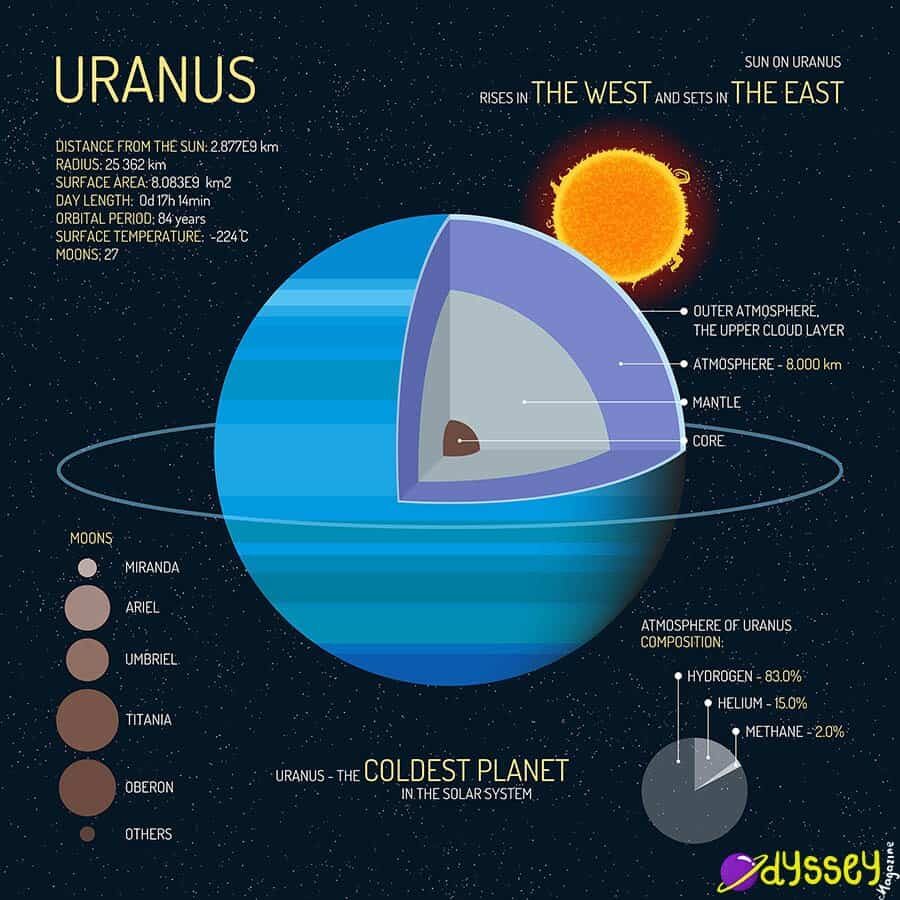
- Uranus is the seventh planet away from the Sun – only Neptune is further away.
- Despite not being the furthest away from the Sun, Uranus is the coldest planet in our solar system.
- The minimum temperature amongst the atmosphere on Uranus is -224°c.
- Uranus has a radius of 15,759.2 miles (25,362 kilometers). This makes it the third biggest planet in the solar system after Jupiter and Saturn.
- Uranus is more than 4x wider than our planet, and has more than 14x its mass.
- Uranus as an estimated distance of 1.8 billion miles (2.9 billion kilometers) from the Sun.
- One full day on Uranus is equal to 17 hours and 14 minutes on Earth.
- However, because of its distance from the Sun, one year on Uranus is equal to 84 years on Earth.
- When Uranus is orbiting the Sun, it travels at an average speed of 15,290 miles per hour (24,607 kilometers per hour).
- Uranus is described as having a blue-greenish color. This is due to the amount of methane in its atmosphere.
The core of Uranus is thought to be made up of a small amount of rocky materials. This is then surrounded by a mantle made up of ice, ammonia and methane. We’re not entirely sure how thick the core of Uranus is, though as with most giant planets, the likelihood is that the surface temperature is much colder than its center.
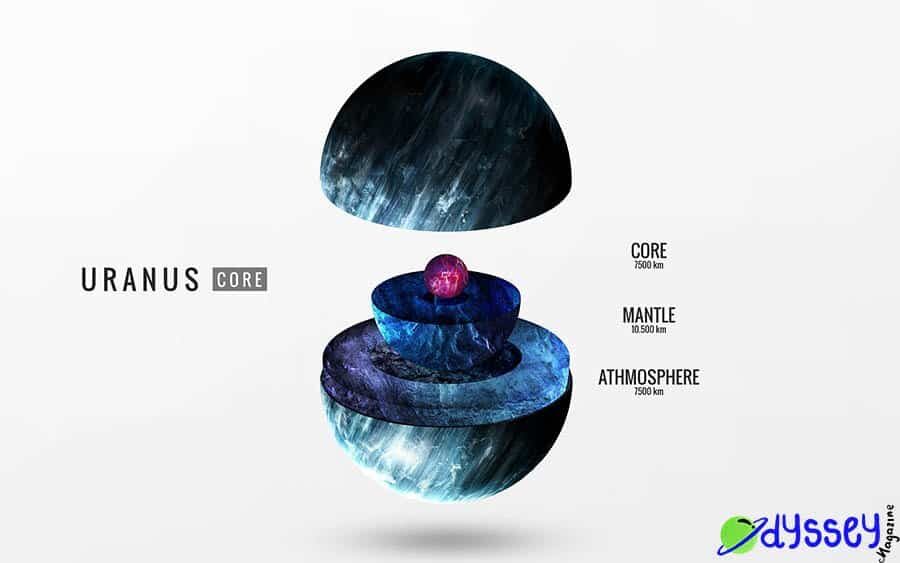
It makes up a large amount of its mass, however, it only makes up around 20% of its radius. Surrounding the core of the planet is the mantle, which is largely ice. Then outside of this, quite a lot of the radius of Uranus is made up of its atmosphere. As it’s quite a dense planet, we can expect the atmosphere here to be pretty unique with its different coloring.
Much of Uranus is actually made up of its atmosphere, which exists of mainly hydrogen and helium (the same as both Jupiter and Saturn). However, Uranus also has a substantial amount of methane in it too, which is why the atmosphere appears green/blue.
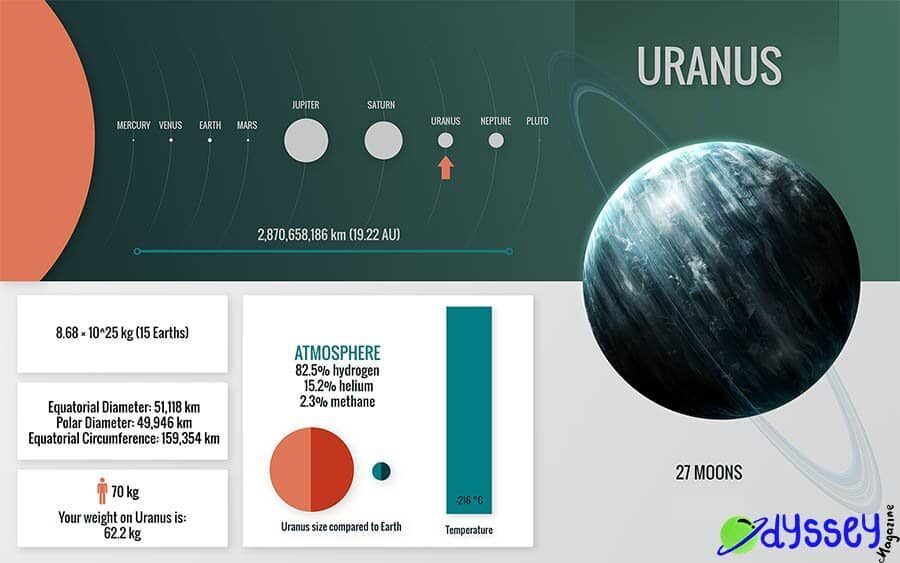
We generally split the atmosphere of Uranus into three different parts; the troposphere, the stratosphere and the thermosphere. These represent the different altitudes and pressures that Uranus has.
Although Jupiter and Saturn are typically talked about for their moons, Uranus also has a good amount too. A the time of writing, there are 27 confirmed moons that are orbiting the big blue planet. The most well known of these moons are the major moons;
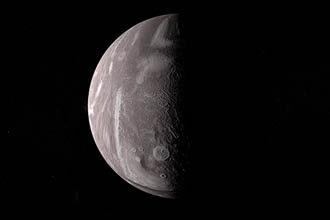
Miranda takes its name from Shakespeare’s play The Tempest. It was discovered in 1948 by Gerard Kuiper, who the Kuiper belt is named after.
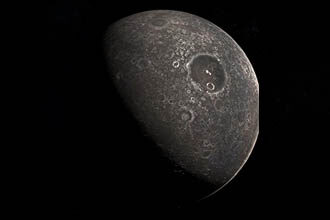
Known for its dark surface, Umbriel is made up primarily of rock and ice. It is the third largest moon of Uranus.
Titania is the largest moon orbiting Uranus, and the eighth largest moon in our solar system overall.
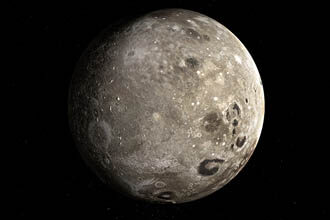
The ninth largest moon in our solar system and second of the Uranus moons, Oberon takes its name from the king of the fairies in Shakespeare’s A Midsummer Night’s Dream.
- Uranus is unique in that essentially its North pole, or axis, is actually pointing at the Sun. Essentially, it’s on its side whilst rotating and orbiting the Sun.
- The surface gravity on Uranus is quite similar to that on Earth. A 200lb man would weigh around 172lbs when on the planet Uranus.
- Uranus atmosphere is primarily made up of the same things stars are made from; hydrogen and helium.
- Although astronomers aren’t sure, we think that the core of Uranus is primarily made up of various different ices.
- We know about 27 moons orbiting Uranus, though there are thought to be many more potentially.
- There are thirteen known rings around Uranus. These are more complex than Jupiter’s rings, but not as extensive as the rings of Saturn.
- Uranus was not discovered until 1781 by astronomers William Herschel with one of his self-made telescopes.
- Unlike the other planets which we know people saw thousands of years ago, Uranus was not written about extensively, because of it’s distance from us it appears quite dim.
- Uranus, along with Jupiter, Saturn and Neptune, are referred to as the ‘gas giants’, as they are made up of gas.
- There has only been one spacecraft that has actually been anywhere near Uranus; NASA’s Voyager 2.
One of the main questions that people have about Uranus is why is it so cold, especially when you learn that it’s actually colder than Neptune, which is a lot further from the Sun. The difference between the heat in these two planets isn’t proven, but the most likely way to explain this is that Uranus generates less heat from it’s core than Neptune does – this may be because Uranus rotates on its side, allowing it’s internal heat to ‘spill out’.
The most confusing thing about planets is that astronomers give them different measurements based on their diameter, radius and their mass. So when we say the “biggest”, it is often misunderstood what exactly “biggest” means. For the most part, big refers to the radius of the planet. If we are talking about the radius, then yes the radius of Uranus is greater than Neptune. But, Neptune has a greater mass than Uranus.
Uranus is a long way away, and it is quite a dim planet in comparison with Venus and the others. However, you can actually see Uranus at times without evening using a telescope. For this, you need clear skies and it needs to be the right time of year.
Yes, Uranus does have clouds, and we generally split the clouds into four different categories; methane clouds, hydrogen sulfide and ammonia clouds, ammonium hydrosulfide clouds and lastly, water clouds. Only the top 2 layers of these clouds are actually visible, as the others are buried deep beneath the others.
The short answer is no. Uranus doesn’t have a solid surface, as the majority of it is made up of it’s atmosphere, which is gas. Even if we could live amongst this mix of hydrogen and helium, Uranus is freezing cold and has no free oxygen for us to breathe. So, no, humans couldn’t survive on Uranus; Mars offers a much better environment for humans to live.
All in all, many people actually find Uranus to be the most interesting of all the planets. This might be because we know so little about it, or because of it’s unique features; like the fact that it’s basically on it’s side the whole time! With 13 rings and 27 moons, Uranus certainly has a lot of explore and learn about.